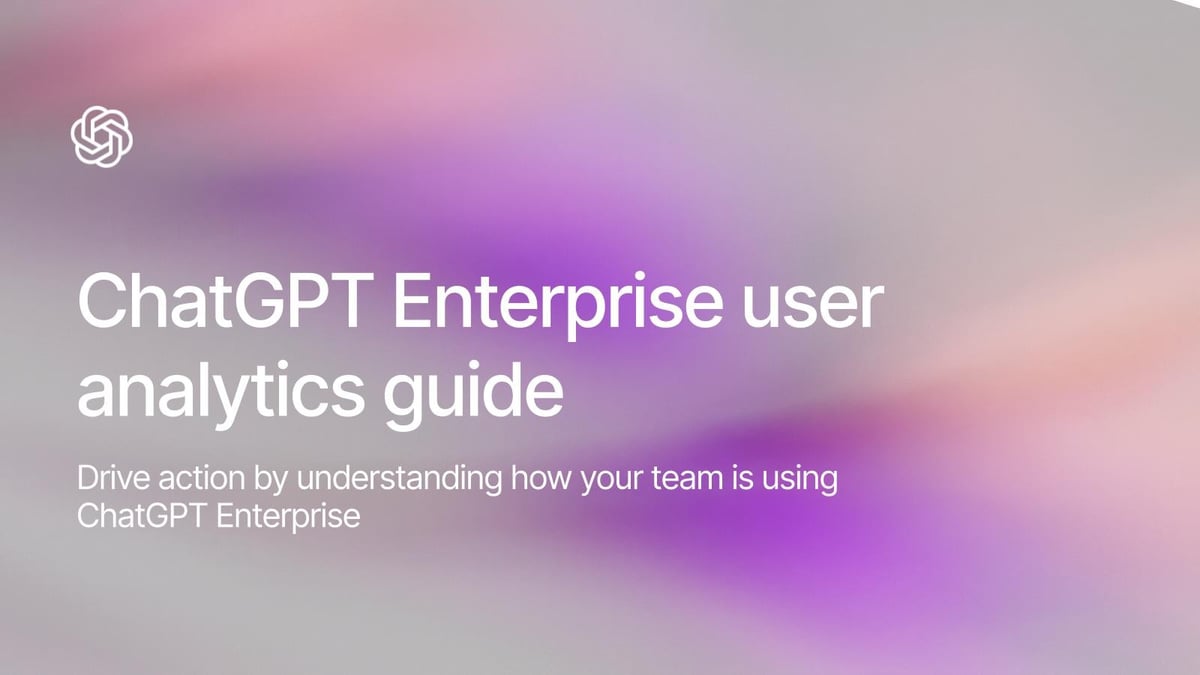ChatGPT Enterprise user analytics guide

# Administrators
# Adoption
Drive action by understanding how your team is using ChatGPT Enterprise
July 7, 2025 · Last updated on August 7, 2025
Interpreting user analytics
The User Analytics Dashboard (available to workspace Owners and Admins) in ChatGPT Enterprise provides a snapshot of adoption and usage patterns across your organization.
- Use the Overview tab to understand total messages, unique active users, tool usage, and GPT message counts. This helps you track baseline engagement and monitor growth over time.
- On the Users tab, sort by message volume to find power users or identify teams with low engagement.
- The GPTs tab lets you evaluate the performance of Custom GPTs—check for those with high message counts and broad reach (unique users). This highlights scalable use cases.
- Export weekly or monthly engagement reports and combine them with internal data to run deeper analyses—like mapping GPT adoption to team KPIs or comparing onboarding cohorts.
These metrics can be used as early signals of momentum and opportunity areas, and they lay the foundation for more advanced analysis when combined with internal performance data or employee feedback. You can see how key metrics are defined in the Help Center article: User Analytics for ChatGPT Enterprise and EDU
Taking action
Now that you understand how to interpret the data, here are a few recommended playbooks to deploy.
Identify power users & champions
Look for users with consistently high message volume and frequency. Their frequent use of ChatGPT often signals that they’ve discovered valuable workflows, use cases, or feature combinations that others haven’t yet explored. By identifying these individuals early, you can amplify their influence and use their experiences to inspire broader engagement.
- Interview these users 1:1 to extract success stories and gather insights on what drives their usage.
- Invite them to join your internal champions network, where they can help onboard peers and share tips.
- Recognize them via internal communications or leaderboards to build momentum and social proof.
- Encourage them to host demos, create how-to content, or lead team-specific enablement sessions.
Spot underutilized groups
Getting ahead of adoption gaps early is critical to ensuring ChatGPT becomes embedded across all teams—not just a few early adopters. Low usage can indicate confusion, lack of awareness, or friction in onboarding that, if left unaddressed, can spread or entrench. Proactively identifying these groups allows rollout teams to deliver timely interventions that remove barriers and demonstrate value before disengagement sets in.
- Slice data by department or group. While ChatGPT will not currently display department names or job titles in the analytics dashboard, you can enrich the data by combining it with internal user directories or HRIS exports. → Compare ChatGPT usage data and internal company data
- Reach out to low-usage teams to understand blockers, leading with empathy and curiosity rather than a punitive mindset. Focus on uncovering friction points or gaps in awareness, and treat these conversations as opportunities to listen, learn, and offer support that meets teams where they are.
- Based on your understanding of the blockers, create an action plan alongside departmental leadership. This may include additional product enablement sessions to boost confidence, more targeted use case discovery to help teams understand how ChatGPT can apply to their specific workflows, or general education to clarify acceptable and responsible use of AI.
Remember to interpret trends with context. Spikes may align with product training or new feature releases, while dips might correspond with holidays or organizational changes. Always verify patterns by cross-referencing with qualitative feedback, and look for sustained usage as a stronger signal than one-time spikes.
Incorporating qualitative feedback
Supplement analytics with feedback from surveys and interviews to gain a more holistic understanding of how ChatGPT is used and perceived across your organization. While dashboards and exports reveal what is happening, a survey can help uncover the why behind trends in adoption, disengagement, or emerging use cases.
Surveys can be sent to entire departments or specific user groups to gather:
- Perceptions of ChatGPT’s usefulness or usability
- Specific tasks where it has made work faster or easier
- Areas where guidance or confidence is still lacking
- Suggestions for new use cases or desired GPTs
Triangulating data insights with real user sentiment enables more targeted enablement, training design, and prioritization of product investments.
Reviewing usage regularly
Reviewing user analytics should be part of your ongoing management and maintenance of ChatGPT Enterprise. Below is an example of a cadence that you can adapt for your internal ChatGPT working group.
Biweekly analytics review
- Review top-line usage stats and week-over-week changes to establish baseline trends and spot shifts that may indicate new engagement or emerging issues. =
- Note team-level patterns and emerging champions by comparing usage across groups and individuals. Tag potential champions and departments that are consistently active or showing growing adoption.
- Decide on 1–2 tactical actions based on your findings—this could include spotlighting a high-impact GPT in internal comms, reaching out to a team lead to gather qualitative feedback, or scheduling a training session for a team with stalled adoption.
- To ensure consistency and efficiency in your analysis, consider building a GPT or using a ChatGPT project with embedded instructions or organizational knowledge. This can help you generate structured outputs, spot trends, and maintain a repeatable reporting cadence.
Quarterly deep-dive
A quarterly deep dive is an opportunity to step back from weekly operations and take a strategic view of ChatGPT's role in your organization. This should be a cross-functional effort—bringing together program owners, departmental leads, IT, and enablement stakeholders to align ChatGPT adoption with your organization's long-term priorities.
- Summarize adoption and feature usage trends by noting growth patterns, tool adoption rates, and emerging use cases.
- Identify top departments and top GPTs to recognize high-performing groups and use cases that can be scaled across other teams.
- Compare usage patterns to business goals to determine whether AI usage is helping achieve strategic outcomes such as productivity gains, cost savings, innovation speed, or user satisfaction.
To guide deeper analysis, here are some questions teams might ask when reviewing ChatGPT adoption data:
- Which teams or departments are most actively using ChatGPT? Why might that be?
- Who are our top power users, and what patterns can we learn from their behavior?
- Are any tools underutilized? What might be the cause?
- Which Custom GPTs are most frequently used, and by whom? Are these use cases repeatable across other teams?
- Are there gaps in usage by function, region, or role that indicate the need for more support or enablement?
- How does usage align with key initiatives or strategic goals (e.g., innovation, efficiency, or customer experience)?
- Do trends in adoption correlate with recent training or leadership messages?
- Are there any teams where adoption is stagnant or declining that require a check-in?
Table Of Contents

